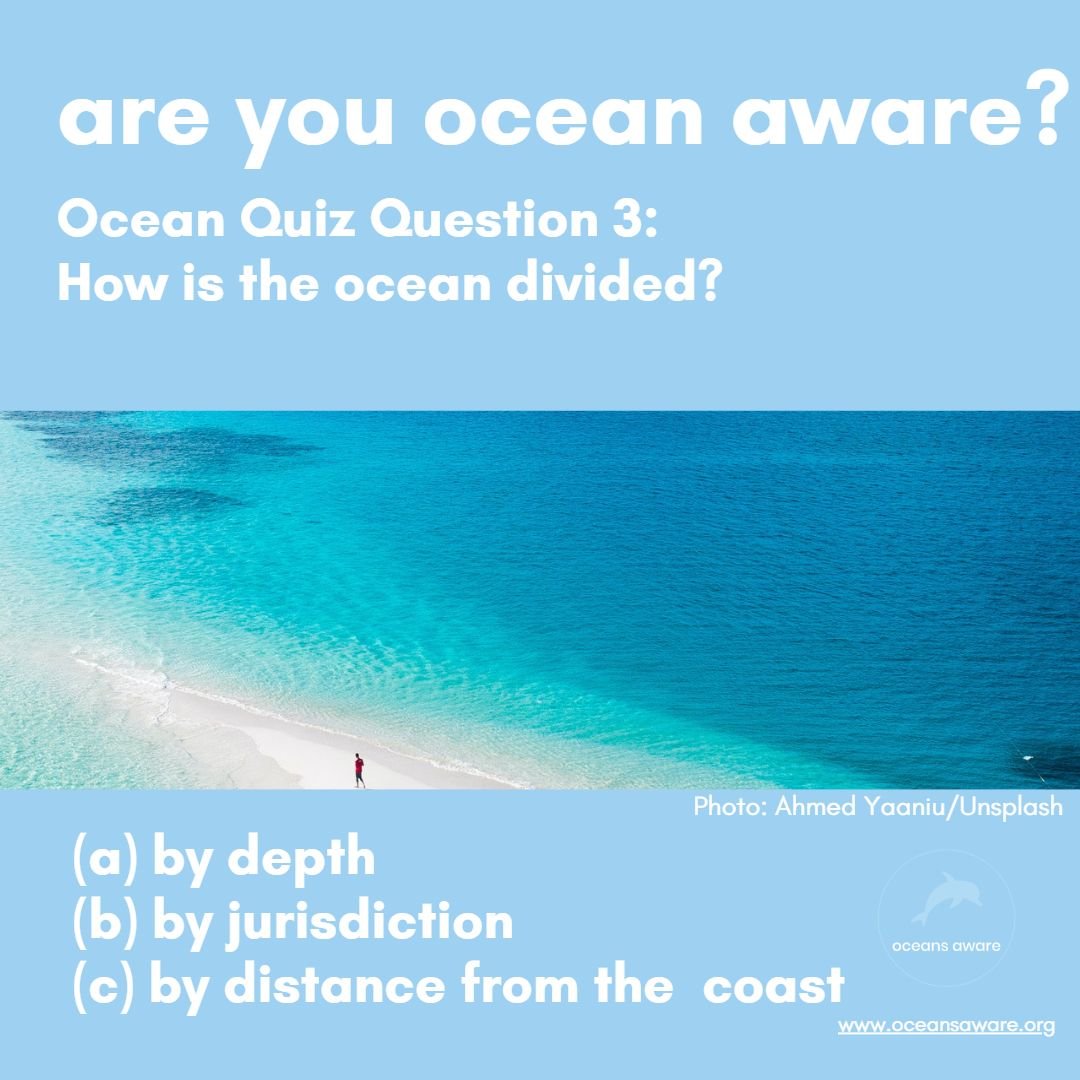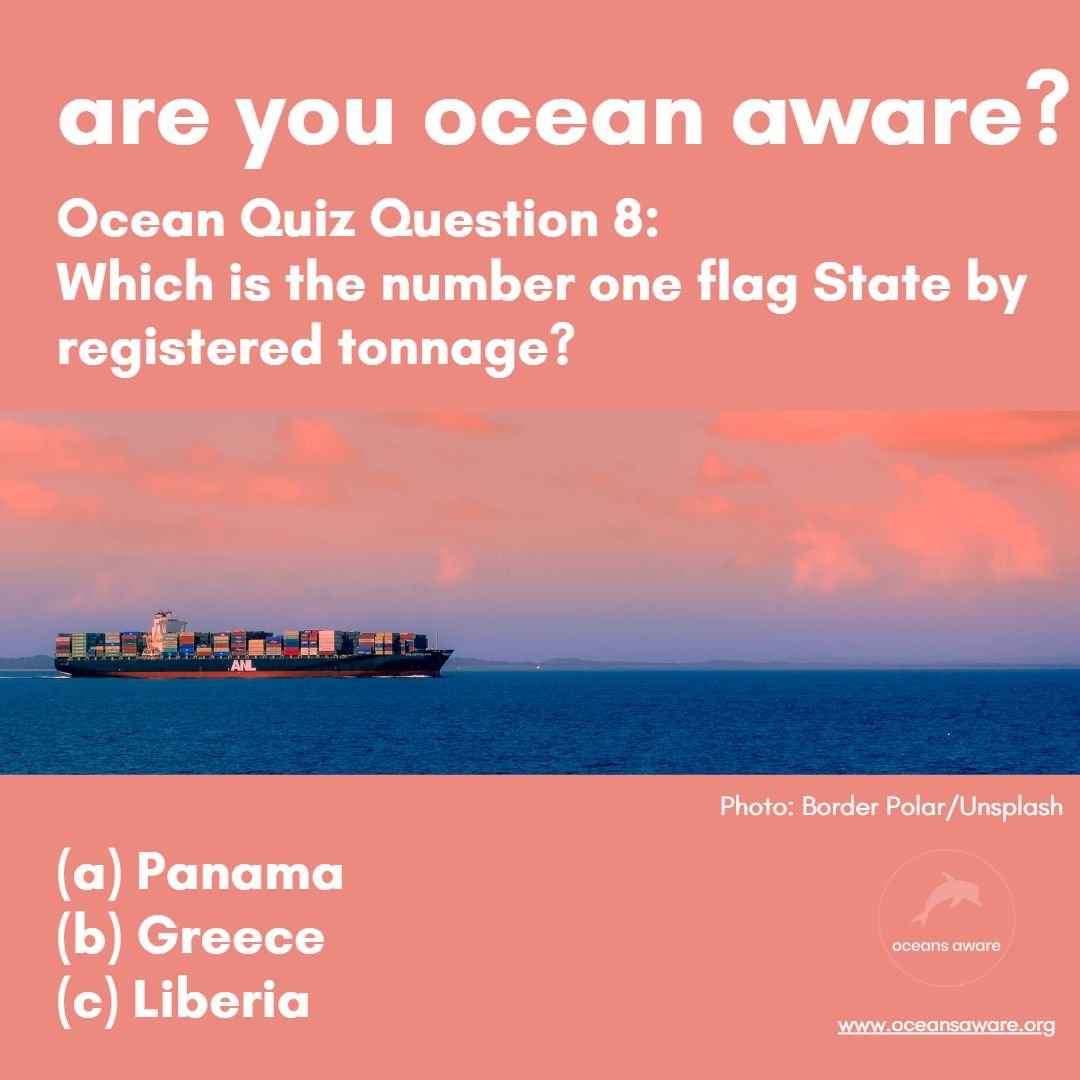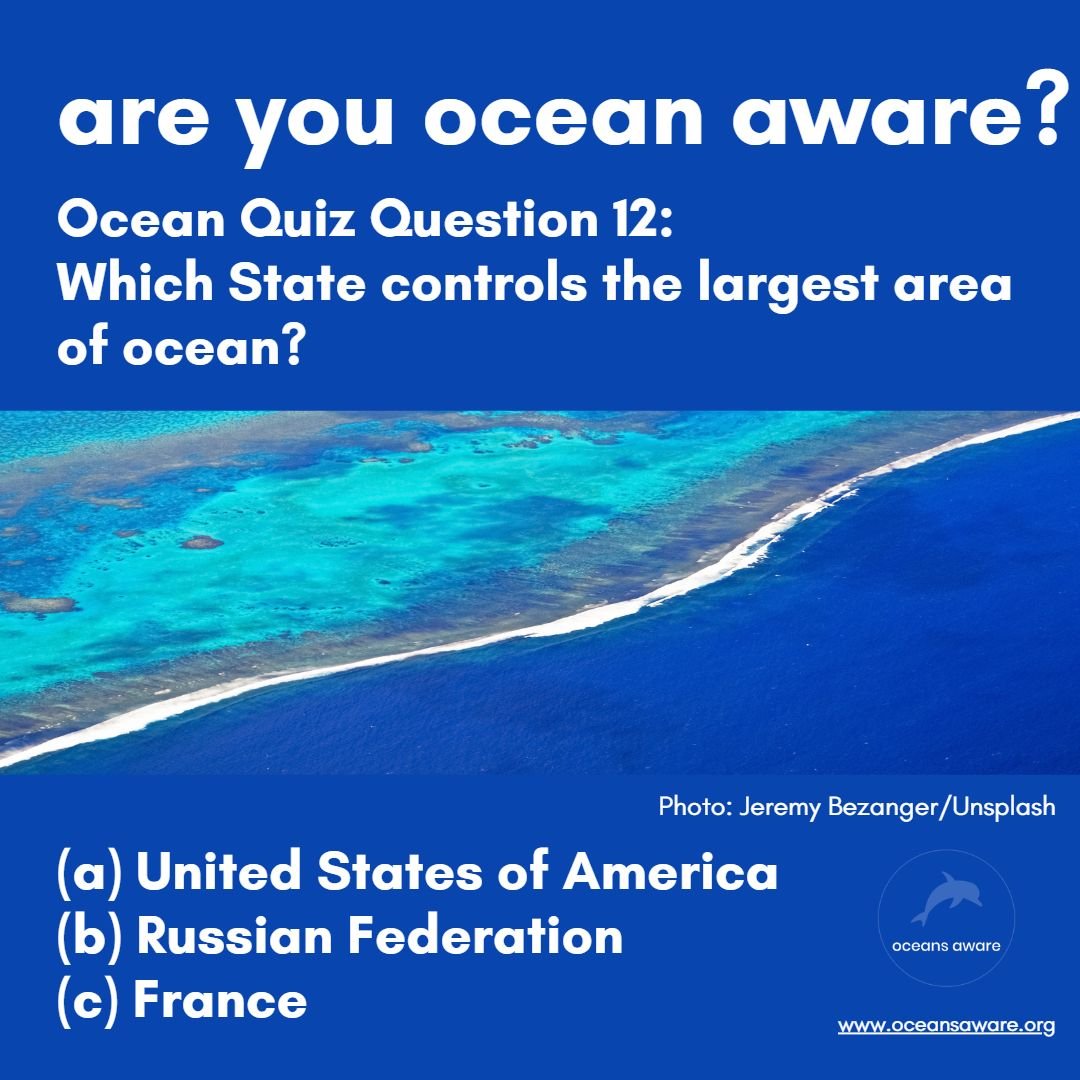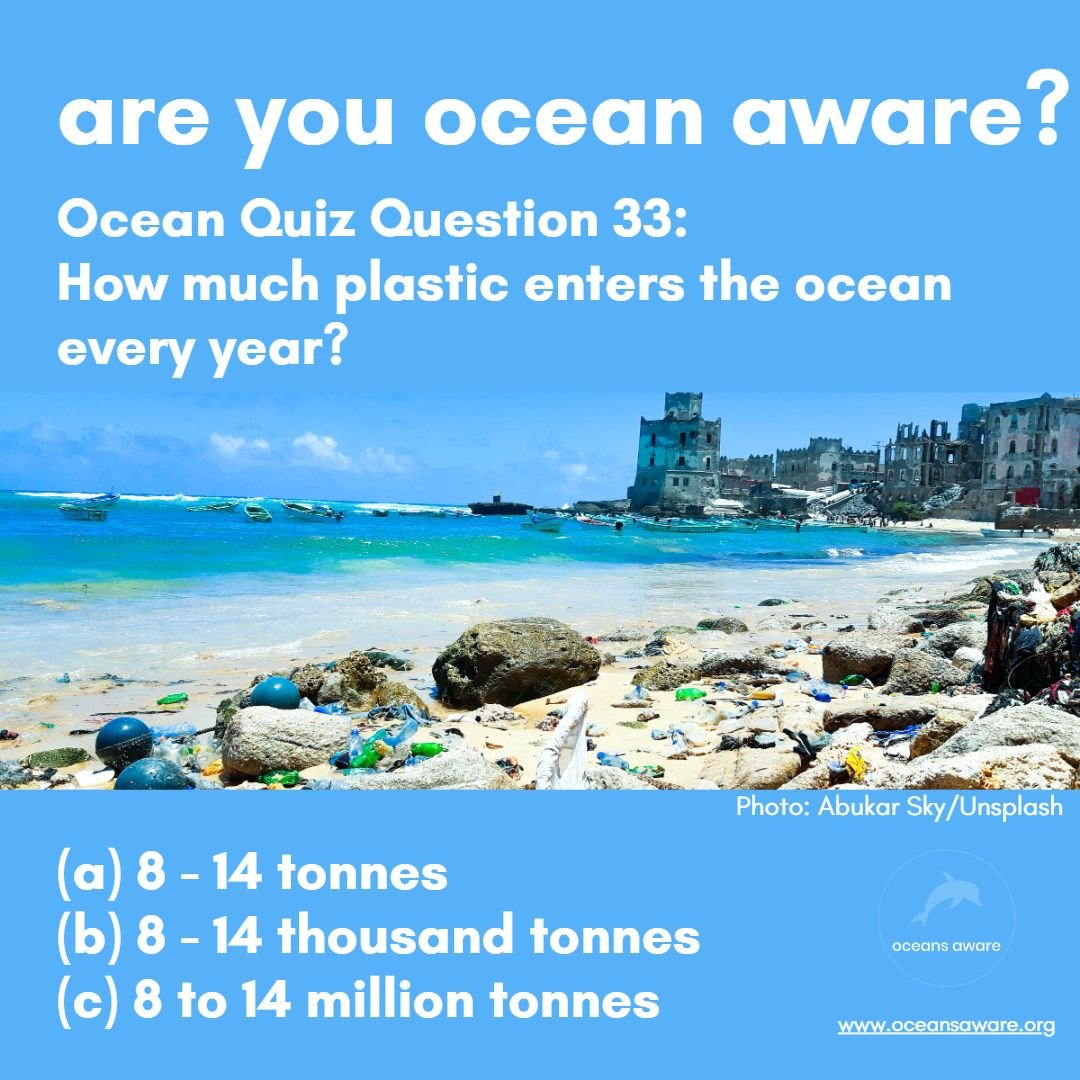ocean awareness quiz
The ocean covers 71% of the Earth, that’s an area of 360 million square km. It provides 99% of the living space and contains 97% of the water on the planet. Although we split the ocean into five oceans and multiple seas it is in fact one interconnected body of water.
Thermohaline circulation, sometimes called the ocean conveyor belt, transfers water, heat, oxygen, carbon, salt, nutrients and, unfortunately, pollution around the planet from the surface to the ocean depths, from the poles to the Equator, helping to balance the global climate and playing a key role in the hydrological cycle. It takes about a thousand years for one loop of the belt to be completed. Climate change is slowing it down.
From a legal perspective, the ocean is divided into zones under the jurisdiction of coastal States, with 36% of the ocean under their control. This system allows a State to exploit resources in an Exclusive Economic Zone, which can extend out 200 nautical miles. Beyond are the High Seas, covering 64% of the ocean or 230 million square km (equivalent to 45% of the Earth’s surface).
The ocean sunlight zone, also known as the epipelagic zone, extends to a depth of 200 metres. It is the brightest and warmest layer (ranging from -2 to 37 °C). The light allows plankton, drifting plants, algae, and some bacteria, to photosynthesise. Below this light slowly diminishes, down to depths of about 1,000 m.
In the midnight or bathypelagic zone there is no light. Bioluminescence is the ability to make light which many fish, plankton, jellyfish and squid have (or they host bacteria which do). Bioluminescence is often used to defend, communicate, find prey or provide camouflage.
The deepest point of the ocean is Challenger Deep in the Mariana Trench in the Pacific Ocean, at just under 11,000 m. Life in the midnight or bathypelagic zone (from 1,000 down to 4,000 m), the abyssopelagic zone (4,000 m to the ocean floor at around 6,000 m) and the ocean trenches or hadalpelagic zone (down to around 11,000 m) is challenging: there is no sunlight, water pressure is high (at the ocean floor this reaches up to 600 times that at the surface) and the temperature remains near freezing.
The United Nations Convention on the Law of the Sea (UNCLOS), often called the ‘Constitution of the Ocean’, establishes a legal framework for the use and protection of the ocean. Since its entry into force in 1994, hundreds more international, regional and bilateral agreements and conventions have been created, regulating ocean-related activities such as shipping, fisheries, and pollution. The other two are the Agreement on Port State Measures (PSMA) of the FAO, which relates to illegal fisheries, and the International Convention for the Prevention of Pollution from Ships (MARPOL) of the IMO.
Every commercial or merchant ship that operates internationally or crosses international borders must be registered with and carry the flag of a State. The flag State is required to inspect it regularly, certify the ship's equipment and crew, and issue safety and pollution prevention documents. Ships come under the jurisdiction of their flag State when underway or the port State while docked in a port. The number one flag State by registered tonnage is Panama, followed by Liberia and the Marshall Islands.
There are 44 States without a coastline but this doesn’t mean that they have no interest in the ocean, some have shipping registries and others use the ocean to conduct trade: UNCLOS gives these States the right of access to and from the ocean and freedom of transit to a nearby port, to be agreed between the land-locked States and transit States concerned through bilateral or regional agreements.
The UN’s Sustainable Development Goal number 14 focusses on Life below water, with the aim to ‘Conserve and sustainably use the oceans, seas and marine resources for sustainable development’. The goal provides a clear call for action with relation to many of the current challenges of ocean governance and sets targets relating to pollution, the preservation and protection of marine ecosystems and ocean resources. Some progress has been made on SDG 14 but it is the least funded of all the 17 goals.
Currently just 8.16% of the ocean is included in 18,427 Marine Protected Areas (MPAs) covering a total area of 29,581,749 square kilometres (as at 27.05.23). 8.7 % of waters under national jurisdiction are designated as protected areas while only 1.44% of the High Seas is protected. The new High Seas Treaty should change this, creating a pathway for MPAs to be created on the High Seas: the goal is protect 30% of the ocean by 2030.
France has the largest EEZ in the world, covering 11.7 million square km, about 9% of the total surface of all the EEZs of the world, whereas the land area of the French Republic is only 0.45% of the total land area of Earth. Second is the United States, followed by Australia. States exercise jurisdiction over all resource-related activities in the EEZ.
Every coastal State is automatically entitled to a continental shelf, reaching up to 200 nautical miles from the baseline, and may exploit the resources found there. The continental shelf can be extended to 350 nautical miles if certain geomorphologic, distance and depth conditions are ascertained and approved by the Commission on the Limits of the Continental Shelf, a 21 member body elected by the Meeting of the States Parties to UNCLOS, based in New York.
Comparing the area of land vs ocean under States’ jurisdiction, there are 83 countries with more ocean than land - of those, 54 States are more than 80% ocean. Tuvalu, Nauru, the Marshall Islands, Micronesia, Kiribati, Maldives, Seychelles, Palau, Tonga and Mauritius are the top ten large ocean (rather than small-island) States.
Discovered near the Galápagos Islands in 1977, hydrothermal vents are found on the ocean floor in volcanic areas. When water penetrates cracks in the Earth’s crust, it is heated, absorbing metals from the surrounding rocks in the process, the water returns to the ocean floor at temperatures of up to 400 °C and is released like a geyser, boiling water carrying metals such as manganese, cobalt, lithium, iron, zinc and copper is spewed out into the near freezing ocean water. Chimney-like towers of deposits can form, some spew water filled with black iron sulphide (named black smokers), others emit white coloured elements like barium, calcium, and silicon (white smokers).
We used to think that sunlight was an essential component for life and that the depths of the ocean were barren but the discovery of hydrothermal vents teeming with life led to the discovery of chemosynthesis and with it a new concept of how life on Earth may have originated over 3 billion years ago. Whilst photosynthesis uses light, chemosynthesis uses the compounds in the water to support life. Specialized bacteria in the areas around the vents convert the sulphur compounds and heat from the water into food and energy. As the bacteria multiply they provide food for other animals such as deep-sea mussels, clams, snails, shrimps, yeti crabs, zoarcid fish and octopuses, acting as a magnet for deep sea life in areas that were once considered barren.
Giant tube worms are found at hydrothermal vents and can grow up to 2 metres in length. They cluster together around vents using hydrogen sulphide, carbon dioxide and oxygen from the water to feed the bacteria they host in exchange for nutrients. The bacteria use the energy from the hydrogen sulphide to convert carbon dioxide into sugars which in return feed the tubeworms, a perfect symbiotic relationship.
23% of global emissions of CO2 are absorbed by the ocean and half of that by coastal plants - mangroves, kelp forests and seagrass beds. Not only are they of immeasurable ecological importance as they provide a habitat for numerous marine species and natural protection against flooding and coastal erosion, they also store carbon dioxide. Their ability to take up carbon from the atmosphere has earned them the name blue carbon.
It is often said that every second breath we take comes from the ocean. While the ocean produces about 50% of the oxygen in our atmosphere marine life also uses this oxygen so really every second breath taken by ALL life on Earth (not just humans) comes from it. Global warming and pollution from agricultural run-off is suffocating the ocean, causing deoxygenation and leaving so-called dead zones of the ocean with dangerously low levels of oxygen, where marine life can’t exist.
Nobody knows! Marine scientists estimate that between 1 and 2 million species inhabit the ocean, from bacteria and microbes up to the largest species to have ever lived, the blue whale with a length of up to 30 metres. About 2,000 new species are described by ocean researchers each year – every research dive brings back new information. It is thought that around 90% of ocean species still await description.
The polar zones, while both covering approximately the same area 14 million square kilometres, are really very distinct: the Arctic is water-based, the Antarctic land-based. The Arctic is the world’s smallest ocean, with an ever-fluctuating floating coverage of sea ice ranging from a few centimetres to around two metres in thickness. Antarctica is a 14.2 million square kilometre landmass, 98 % of which is covered by ice up to 4,700 metres thick, surrounded by the Southern Ocean.
No, even if we do manage to keep to a 1.5 °C increase we are still looking at the loss of 70 to 90% of warm water coral reefs within 20 years. Coral reefs cover less than 0.1% of the ocean floor but provide a protective habitat, nursery area, food and shelter for about 25% of marine life. In addition to warming temperatures, ocean acidification, overfishing, agricultural runoff, plastic pollution and sedimentation from urban development and land reclamation activities threaten the health of coral reefs around the world.
Geologists have mapped the topography of the planet and astronomers the sky above us but the ocean is still largely unexplored. The hostile environment of the ocean floor with no light and enormous water pressure means that only specialized submarines can reach these depths to observe, collect samples or record footage. The result is that 95% of the ocean is still unexplored. Research vessels and submersibles are limited - States need to do more, currently just 1.7% of annual research budgets are allocated to the ocean.
90% of goods are carried around the world by ships. Thousands of container ships, bulk carriers and tankers cross the ocean every day. The world fleet currently comprises just under 100,000 ships of 100 gross tons or more, registered in over 150 nations, crewed by over a million seafarers and carrying cargo all over the world.
If the ocean were a national economy, it would be the seventh largest in the world. Ocean resources have been estimated to be worth US$ 24 trillion while the OECD estimates that the annual market value of all marine and coastal resources and industries could reach US$ 3 trillion by 2030.
The first cable was laid in 1858 from the USA to Ireland. What took 16 hours to arrive back then is now accomplished in seconds: 97% of our communications are possible thank to over 400 underwater cables about 1.2 million km long. The advent of fibre optics in the 1990s made sea cabling possible so that now almost all data transfers are carried across the ocean in cables about as wide as a garden hose, made up of filaments carrying light signals which have a diameter roughly the size of a human hair.
80% of the tourism industry has an ocean connection – generating about €115 billion/year. Doctors have been prescribing sea air as a tonic since the 18th century, the benefits of proximity to or activity in the ocean include stress reduction, enhanced relaxation, physical and mental stimulation and spiritual cleansing.
Marine Genetic Resources are chemicals or genes derived from marine plants, animals or microorganisms. A rapidly growing industry of enormous importance to chemical, cosmetic and pharmaceutical companies, more than 300 companies, research institutes and universities have already laid claim to sequences from nearly 1,000 marine species. MGRs have been used in the fight against HIV, cancer, tuberculosis, malaria, arthritis and Alzheimers and, more recently, Ebola and coronaviruses.
About 80% of ocean pollution comes from land, just 20% from ships. Be it plastic, wastewater, agricultural runoff, oil, discarded fishing nets, rubbish from insufficient waste disposal procedures, containers falling off ships or noise: the ocean is fighting a losing battle against pollution - marine life is being severely impacted by it. Between 8 and 14 million tonnes of plastic (including about 640,000 tonnes of fishing gear) 2.1 million tonnes of oil, and uncounted amounts of industrial waste, wastewater and untreated sewage enter the ocean every year. The impact of seabed mining is yet to be seen although severe noise, light and sediment pollution is to be expected.
The London-based International Maritime Organization, or IMO, is responsible for setting and maintaining global standards and a regulatory framework for the safety, security and environmental performance of international shipping. In accordance with IMO regulations, a ship's flag State is required to inspect it regularly, certify the ship's equipment and crew, and issue safety and pollution prevention documents.
The ISA is the International Seabed Authority, based in Kingston, Jamaica, the WMO, the World Meteorological Organization, is based in Geneva, Switzerland.
Sound travels in air at 343 metres a second, in water this increases to 1,480 metres a second! Recognized by the World Health Organization as a global pollutant since 2011, noise can cover thousands of kilometres in the ocean without significant loss of energy. This means that the noise made by ship propellers, by submarine sonar or seismic exploration guns radiates out for thousands of kilometres with an enormous and inescapable negative impact on marine life.
According to the Food and Agricultural Organization of the United Nations, at least 640,000 tonnes of fishing gear is thought to be lost or abandoned in the ocean every year. It makes up about 10% of all marine debris and is by far the most harmful form of debris because the nets continue to catch fish and trap marine mammals for decades after they have entered the marine environment, thus the name ghost fishing.
80% of all land-based pollution is plastic: somewhere between 8 and 14 million tonnes finds its way into the ocean every year as a result of inadequate waste management, neglect and ignorance. Once there it starts to break up into macroplastics, microplastics and nanoplastics. Macroplastics are larger than 5 mm, microplastics measure between 1 μm and 5 mm and nanoplastics cover anything smaller than 1 μm.
We catch about 90 million tonnes of fish a year, far more than is sustainable. There are about 4.6 million fishing vessels, most of which small vessels fishing close to the coast but about 64,000 of these are larger than 24 metres in length and capable of operating in distant ocean waters. According to The PEW Charitable Trusts, the total capability of the world’s fleets is estimated at 250% of sustainable levels of catch.
About 93% of the excess heat caused by climate change is absorbed by the ocean. Marine heatwaves, a period of five days or more when the sea surface temperature is significantly warmer than average are on the rise, devastating ecosystems and impacting marine species. As temperatures rise the nutrition available and fish stocks react accordingly, generally moving poleward to remain within their preferred temperature and nutritional ranges.
When water temperatures rise by just 1 to 2°C, the polyps expel the algae within them. As the algae are lost from the tissue the white skeleton shines through the mostly transparent host tissue, giving the corals a whitish appearance. If the water temperature doesn’t drop and therefore allow the algae to return, the polyps starve, succumb to disease and die, the skeletons are then covered by a different type of algae, changing to a grey/green colour. Without live tissue, the reef is exposed to the eroding forces of the environment and the framework breaks down within a few years.




































